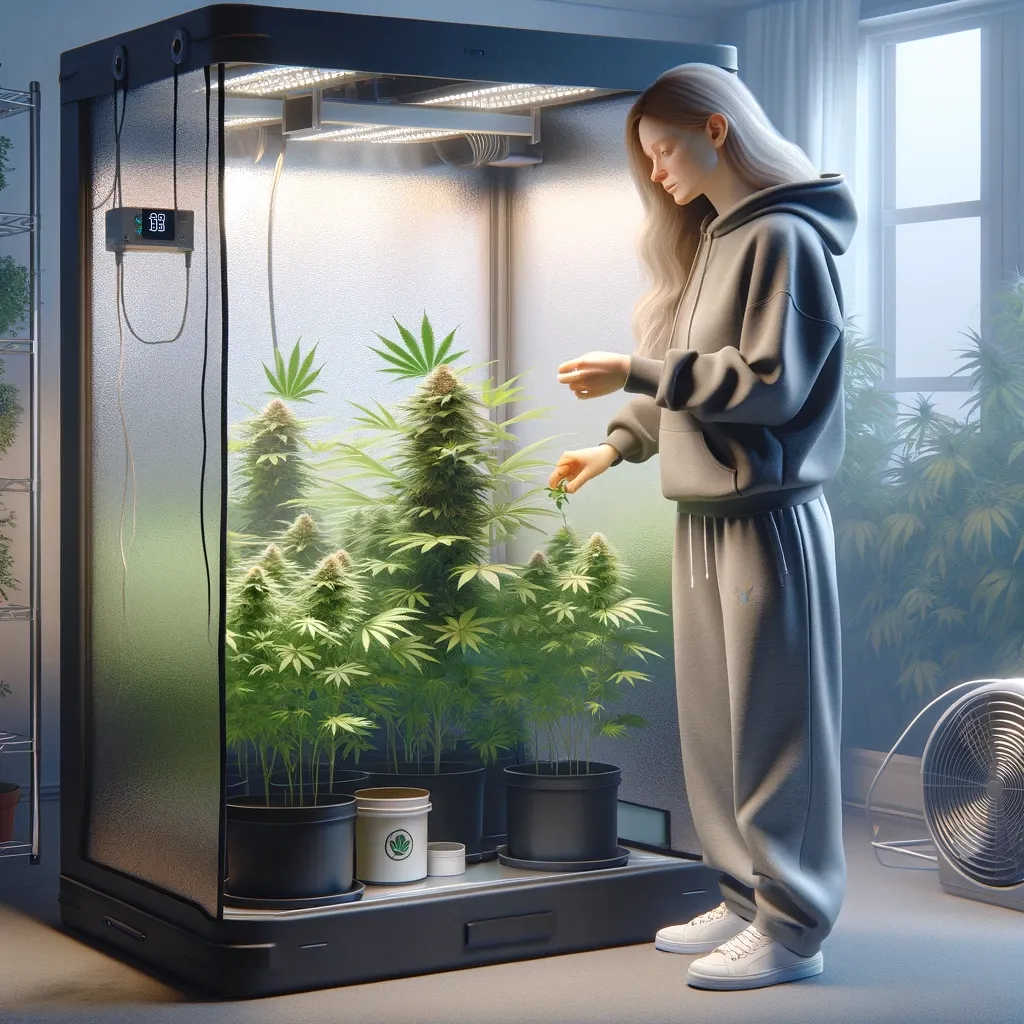Discover the Secrets of Growing Premium Cannabis at Home
Are you tired of overpaying for subpar cannabis at dispensaries? What if I told you that you could grow your own top-shelf buds right from the comfort of your own home, 100% legally? My name is Adam, and I've been successfully cultivating cannabis for over a decade. Through trial and error, I've developed foolproof methods for growing potent, flavorful buds that rival anything you'd find in a dispensary.
Who Is Cannabis Khan?
Discover the world of growing your own top-quality cannabis right at home with our "Cannabis DIY" online course. This step-by-step program will take you through everything you need to know to grow the best buds, from setting up your grow space to harvesting and drying your plants.
Our teachers will walk you through all of the important skills and tricks to get a huge crop of strong, tasty bud.
You'll find out how to pick the best strains for your setup, grow your plants using natural and organic methods, and give them the perfect food and care to get the most buds possible.
As you go through the course, you'll have access to detailed videos, fun quizzes, and a group of friendly growers who love cannabis as much as you do. You can expect 1:1 hands on support from our experienced mentors, who will be there to help you with any questions or problems you might have along the way.
By the time you finish the "Cannabis DIY" program, you'll have the knowledge and practice to grow amazing cannabis at home, all by yourself. Whether you're totally new to growing or you've tried it before and want to get better, this course will help you become a master cannabis grower and enjoy your own top-quality buds for years to come.
The CK Blog

Exploring Germination Methods
“From a tiny seed a mighty trunk may grow.”
- Aeschylus
Hey there, Cannabis Khan community! Good to be back for another week.
Today, we're hopping into the world of germination methods.
A simple and straight forward topic, but a necessary one to master for a successful grow.
We recently started a grow of Girl Scout Cookies, a popular hybrid, and thought it would be relevant to break down the different germination options for you all this week, as there are a few.
What Is Germination?
Before we jump into the different methods you can use, let's quickly recap what germination is. It's the process where a seed sprouts and begins to grow into a seedling. For cannabis, this is the first stage of the plant's life cycle.
Popular Germination Methods
There are several ways to germinate cannabis seeds, each with its own set of pros and cons. Let's explore some of the most common methods:
1. Paper Towel Method (Our First Choice)
This is the method we opt for when performing our germination process on all of our grows. Usually takes about 24-72 hours for a taproot to emerge from your seeds using this method.
Pros:
Easy to monitor progress
High success rate
Inexpensive and simple
Cons:
Seeds can be damaged if not handled carefully
Risk of mold if paper towels are too wet
How-to: Place seeds between damp paper towels, put them on a plate (thin glass works well). Keep in a warm, dark place and check 1-2 times daily. We recommend using a heating mat as well, which usually keep a temperature range of about 70-80 degrees F. For dry climates, consider placing set-up inside of a Ziploc bag (don't seal completely) to retain moisture, particularly overnight.
Tip: Use spray bottle (with distilled water) to ensure you don't overwater and for easy application. You always want the paper towels to be moist, just not pooling with water.

2. Direct Soil Planting
Pros:
Minimizes transplant shock
Mimics natural growing conditions
Less handling of delicate seedlings
Cons:
Slower germination
Harder to monitor progress
Less control over environmental factors
How-to: Plant seeds directly into your growing medium, about 1/4 inch deep. Keep soil moist and warm.
3. Water Soaking Method
Pros:
Can speed up germination for older seeds
Simple and cost-effective
Cons:
Risk of drowning seeds if left too long
Seeds can be fragile after soaking
How-to: Soak seeds in a glass of room temperature water for 24-32 hours. Plant those that sink and have a visible taproot.
4. Rockwool Cubes
Pros:
Excellent water retention
Good for hydroponic setups
Easy to transplant
Cons:
Need to adjust pH
Not biodegradable
Can be too wet if not properly prepared
How-to: Soak Rockwool cubes in pH-adjusted water, place seed in the hole, and keep in a warm, humid environment.
5. Germination Stations
Pros:
Provides ideal humidity and temperature
High success rates
Good for larger-scale operations
Cons:
More expensive than other methods
Requires electricity
Can be overkill for small grows
How-to: Follow manufacturer instructions, usually involving placing seeds in provided trays and setting temperature/humidity controls.
Why We Opt for the Paper Towel Method
For our most recent grow, Girl Scout Cookies, we opted for the paper towel method. Here's why:
Visibility: Easy to check on the seeds without disturbing them too much.
Control: Easy to maintain optimal moisture levels, especially using a spray bottle.
Success Rate: We've had great results with this method in the past.
Simplicity: It doesn't require any special equipment or setup. Super easy.
And there you have it, fellow cannabis enthusiasts! We've explored the ins and outs of germination methods (with a special focus on our current Girl Scout Cookies grow). Remember, whether you choose the paper towel method like us, or any other technique, the key is to provide your seeds with the right balance of moisture, warmth, and darkness.
And with that, we'll catch you next week, CK Community! Happy growing, everyone!
What your Going
to Love about us.
We go beyond expectations so you can enjoy the grow. Our customers rave about the service, selection, and savings they discover here every day.

Online Course
In this comprehensive Cannabis DIY course, you'll learn everything you need to know to successfully cultivate your own top-quality cannabis plants at home. Our expert will guide you through each step of the process, from selecting the right strains and setting up your grow space to mastering advanced techniques for maximizing yields and potency.

Coaching
Take your cannabis growing skills to the next level with our personalized 1-on-1 coaching sessions. Our expert instructor will work closely with you to assess your unique needs, challenges, and goals, providing tailored guidance and support to help you achieve optimal results in your home grow.
Why you should start Growing ?
Hey, have you ever thought about growing your own cannabis? It might seem tough, but it's totally worth it. You'll have complete control over the quality and save a ton of money.
When you grow your own, you know exactly what's in it – no harmful chemicals. Plus, you get to choose your favorite strains and make it just how you like.
Growing cannabis is also a really rewarding hobby. It's amazing to watch your plants grow from seeds into beautiful, bud-filled plants. And when you harvest, you'll feel so proud of what you made.
The best part? You don't need to be an expert. Our Cannabis DIY course will give you all the knowledge and support you need. We'll guide you through every step, from setup to harvest.
So why not give it a try? You'll have a blast learning something new and end up with amazing cannabis that you grew yourself. There's nothing like it. Start your cannabis growing journey today!
Gallery




It's Time to Find Your Perfect Strain
Discover the perfect cannabis strains for your home grow with Cannabis Khan's innovative Strain Selection AI Agent! Simply click the button below to access our cutting-edge tool and answer a few quick questions about your grow setup, experience level, and desired effects. Our AI algorithm will analyze thousands of data points to generate personalized strain recommendations tailored to your needs, complete with detailed profiles on yield, flowering time, optimal conditions, and effect/flavor profiles. Take the guesswork out of strain selection and unlock the full potential of your homegrow - click now to find your ideal cannabis match!
Questions? We Have Answers!
Is it legal to grow cannabis at home?
The legality of growing cannabis at home varies depending on your location and the specific laws in your area. Some states and countries have legalized home cultivation for personal use, while others have more restrictive policies. It's crucial to research and understand the laws in your jurisdiction before starting your home grow. Our course provides general information, but it's your responsibility to ensure compliance with local regulations. https://en.wikipedia.org/wiki/Legality_of_cannabis_by_U.S._jurisdiction
How long does it take to grow cannabis from seed to harvest?
The total time from seed to harvest varies depending on the strain, growing conditions, and techniques used. On average, cannabis plants take about 3-5 months to complete their life cycle. This includes the germination phase (1-2 weeks), vegetative phase (3-8 weeks), and flowering phase (6-12 weeks). However, factors such as the specific strain, light cycle, and environmental conditions can influence the growth rate and harvest timeline. Our course provides detailed information on each growth stage and offers tips for optimizing your timeline.
What is your refund policy?
Refund Policy: All sales of our Cannabis DIY course and related digital products are final. Due to the nature of digital products, we are unable to offer returns, refunds, exchanges, or credits for partially used or unused courses, coaching sessions, or other digital products. By completing your purchase, you acknowledge that you have read and agree to this refund policy. If you have any questions or concerns about the course content or your purchase, please contact our customer support team at [email protected] prior to making your purchase.
Get In Touch
Address: 7506 W 10th Avenue, #3, Lakewood Colorado 80214
Email: [email protected]
Phone: (716) 790-9908
Hours of Operation:
Mon - Sat 8am to 6pm
Sunday – Closed










Facebook
Instagram
X
Youtube